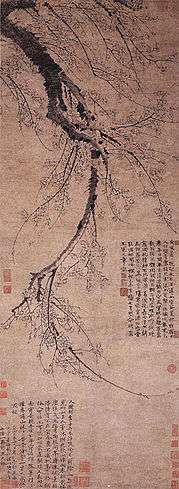Wang Mian


Wang Mian (Chinese: 王冕; pinyin: Wáng Miǎn; Wade–Giles: Wang Mien) (1287–1359) was a Chinese painter during the Yuan Dynasty (1271–1368).[1]
Wang was born in Zhuji the Zhejiang province.[2] His style name was Yuanzhang (元章)[3] and his sobriquets were "Zhushi Shannong" (煮石山農), "Fangniu Weng" (放牛翁), and "Meihua Wuzhu" (梅花屋主). Wang Mian aspired to be an official, but when he failed he turned to painting for a living. He painted plum blossoms as metaphors against the ruling Mongols of the Yuan Dynasty.[4] Wang developed his own distinct style of painting plum blossoms that was very bold and vigorous. He edited the "Manual of Plum" to describe his experiences of plum-painting. A friend wrote " Those who sought out his paintings came in crowds, and stood back to shoulder to watch. He used paintings on long and short lengths of silk in order to earn what he needed for rice. When people mocked him, Wang Mian said, ' I depend on this for my livelihood. Why, otherwise, would I want to be a painting master working for others?'"
| Wikimedia Commons has media related to Wang Mian. |
References
- ↑ Barnhart: Pages 192-193.
- ↑ "Wang Mian Brief Biography". Retrieved 2008-07-11.
- ↑ "故宮書畫數位典藏資料檢索". Taipei: National Palace Museum. Retrieved 30 August 2011.
- ↑ Dudbridge, Glen; Berg, Daria (2007). Reading China. Leiden: Brill. p. 58. ISBN 978-90-04-15483-4.
- Barnhart, R. M. et al. (1997). Three thousand years of Chinese painting. New Haven, Yale University Press. ISBN 0-300-07013-6
External links
- Wang Mian's Plum Paintings at China Online Museum
- Works by Wang Mian at Project Gutenberg
- Sung and Yuan paintings, an exhibition catalog from The Metropolitan Museum of Art Libraries (fully available online as PDF), which contains material on Wang Mian (see list of paintings)